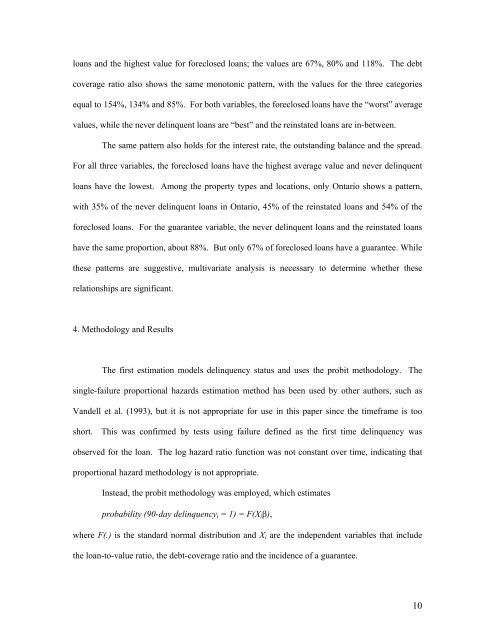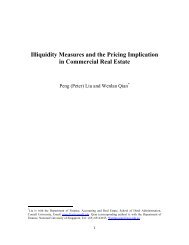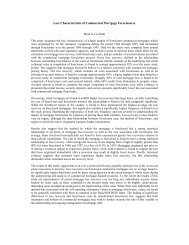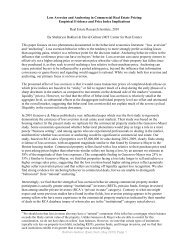Commercial Mortgage Delinquency, Foreclosure and Reinstatement
Commercial Mortgage Delinquency, Foreclosure and Reinstatement
Commercial Mortgage Delinquency, Foreclosure and Reinstatement
Create successful ePaper yourself
Turn your PDF publications into a flip-book with our unique Google optimized e-Paper software.
loans <strong>and</strong> the highest value for foreclosed loans; the values are 67%, 80% <strong>and</strong> 118%. The debtcoverage ratio also shows the same monotonic pattern, with the values for the three categoriesequal to 154%, 134% <strong>and</strong> 85%. For both variables, the foreclosed loans have the “worst” averagevalues, while the never delinquent loans are “best” <strong>and</strong> the reinstated loans are in-between.The same pattern also holds for the interest rate, the outst<strong>and</strong>ing balance <strong>and</strong> the spread.For all three variables, the foreclosed loans have the highest average value <strong>and</strong> never delinquentloans have the lowest. Among the property types <strong>and</strong> locations, only Ontario shows a pattern,with 35% of the never delinquent loans in Ontario, 45% of the reinstated loans <strong>and</strong> 54% of theforeclosed loans. For the guarantee variable, the never delinquent loans <strong>and</strong> the reinstated loanshave the same proportion, about 88%. But only 67% of foreclosed loans have a guarantee. Whilethese patterns are suggestive, multivariate analysis is necessary to determine whether theserelationships are significant.4. Methodology <strong>and</strong> ResultsThe first estimation models delinquency status <strong>and</strong> uses the probit methodology. Thesingle-failure proportional hazards estimation method has been used by other authors, such asV<strong>and</strong>ell et al. (1993), but it is not appropriate for use in this paper since the timeframe is tooshort. This was confirmed by tests using failure defined as the first time delinquency wasobserved for the loan. The log hazard ratio function was not constant over time, indicating thatproportional hazard methodology is not appropriate.Instead, the probit methodology was employed, which estimatesprobability (90-day delinquency i = 1) = F(X i β),where F(.) is the st<strong>and</strong>ard normal distribution <strong>and</strong> X i are the independent variables that includethe loan-to-value ratio, the debt-coverage ratio <strong>and</strong> the incidence of a guarantee.10





